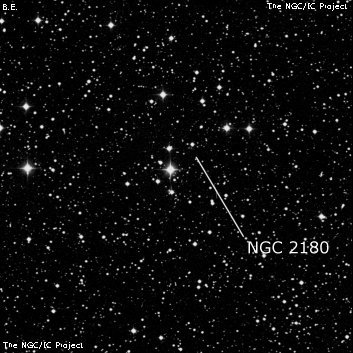
William Herschel discovered NGC 2180 = H VIII-6 = h380 on 24 Jan 1784 (sweep 114) and reported "A Cl of scattered stars, about 30 large and many small ones." A later sweep provided an accurate position. On 2 Feb 1831 (sweep 320), John Herschel called it a "a fine cluster, coarse, p rich, place of a *9m." His position corresponds with mag 8.4 SAO 113523 at 06 09 37.6 +04 43 03 (2000).
Karl Reinmuth, in his 1926 photographic survey, lists dimensions of 20'x20' with the description "Cl, L, pR, P, sc, st 8.7..., B* BD+4d1141 nr M." RNGC classifies this object as nonexistent (Type 7), though a recent journal article suggests this is an evolved, disrupted cluster (A&A 427, 485-494 (2004).
400/500mm - 18" (3/5/05): large, scattered group viewed at 115x with the 31mm Nagler. Most distinctive is a "candy-cane" loop of a dozen mag 10-11 stars which closely wrap around to the east of mag 7.9 HD 29212 and then extends in a string to the NW ending in two mag 10 stars. A scattering of brighter stars in the vicinity increase the apparent diameter to perhaps 20'x15', though besides the half-dozen or so brighter stars this appears to be an asterism. A half-dozen mag 8.5-10 stars 10' to 12' E and north from the mag 7.1 star roughly define an eastern border to the group. Listed as nonexistent in the RNGC though this may be an evolved, open cluster remnant that is partially stripped of former members.
Notes by Steve Gottlieb